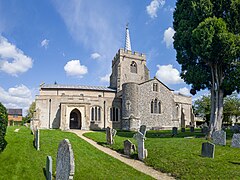
Summary
Anstey is a village and civil parish in the East Hertfordshire district of Hertfordshire, England, about 15 miles (24 km) northeast of Stevenage. According to the 2001 census the population of the parish was 338, reducing to 299 at the 2011 census.[1]
| Anstey | |
|---|---|
 St George's Church, Anstey | |
 Anstey Location within Hertfordshire | |
| Population | 299 (2011 census) |
| Civil parish |
|
| District | |
| Shire county | |
| Region | |
| Country | England |
| Sovereign state | United Kingdom |
| Post town | Buntingford |
| Postcode district | SG9 |
| Police | Hertfordshire |
| Fire | Hertfordshire |
| Ambulance | East of England |
| UK Parliament | |
The name "Anstey" derives from the Old English ān (narrow, or one-way) and stīg (footpath).[2]
There are at least two books on the history of this village. The first is Anstey, a Hertfordshire Parish, written in 1929 by Rev Frank Ricardo Williams, MA, who was the rector from 1907 to 1928 (died 19 May 1937). The second is Anstey: Our True Surname Origin and Shared Medieval Ancestry by GM Anstey and TJ Anstey in which it is shown that all bearers of the surname 'Anstey' worldwide can trace their surname origin to Anstey in Hertfordshire.
The Church of England parish church of Saint George is a cruciform building of flint with stone dressings. Its earliest parts are the chancel, transepts and crossing tower, all of which were built in the 12th century. The church was altered in the 13th century and the nave was rebuilt in the 14th century. The south porch and the top stage of the tower are 15th century. The church was restored in 1871–72 under the direction of the Gothic Revival architect William Butterfield. Repairs in 1907 were directed by the architect Arthur Blomfield. St George's is a Grade I listed building.[3] The lychgate is a separate Grade II listed building, as it incorporates a lockup which was apparently used until the beginning of the 20th century.[4]
In his book 'England's Thousand best churches' (revised edition 2002), Simon Jenkins refers to a near-miss when a fully-loaded WW2 bomber nearly crashed into the church. This is reference to the crash of a Flying Fortress which crashed on take-off en route to Cologne: all ten crew were killed. Jenkins refers to the church as 'full of Norman mystery'. He pays particular interest to the church font, in which (and very unusually) four mermen are carved into the stone. Jenkins refers to the carvings as '...the rarest of pagan emblems'.
A folk tale tells of a fiddler from Anstey named Blind George, who disappeared while exploring an underground passage. He is said to have entered the tunnel playing his fiddle, which could be heard above ground. He stopped suddenly, and screams were heard, and he was not seen again.[5]
The village has a pub, The Blind Fiddler, which used to be called The Chequers.[citation needed]
See also edit
References edit
- ^ "Civil Parish population 2011". Neighbourhood Statistics. Office for National Statistics. Retrieved 25 October 2016.
- ^ Field, John (1980). Place-names of Great Britain and Ireland. Newton Abbot, Devon: David & Charles. p. 24. ISBN 0389201545. OCLC 6964610.
- ^ Historic England. "Church of St George (Church of England) (Grade I) (1101870)". National Heritage List for England. Retrieved 28 July 2018.
- ^ "National Heritage List for England, Lychgate, Anstey". Retrieved 23 August 2023.
- ^ Thomas, Llinos (21 May 2009). "Medieval graffiti and mermen – Anstey – Towns and Villages – Herts Memories". Herts Memories. Retrieved 29 August 2014.
External links edit
- Media related to Anstey, Hertfordshire at Wikimedia Commons
- Anstey (A Guide to Old Hertfordshire)
- Anstey in the Domesday Book
51°58′35″N 00°02′37″E / 51.97639°N 0.04361°E


